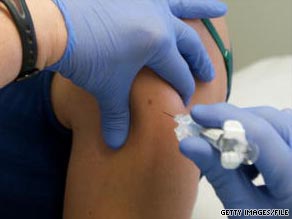ATLANTA, Georgia (CNN) -- The Food and Drug Administration has approved applications from four manufacturers to make H1N1 flu vaccine, the secretary of the Department of Health and Human Services said Tuesday.

"We will have enough vaccine available for everyone," Kathleen Sebelius told the House Energy and Commerce Committee.
The plan is to begin the large-scale vaccination program in mid-October in as many as 90,000 sites, though limited amounts of the vaccine are expected to be available a week to 10 days earlier, she said.
Monday, the director of the nation's top disease agency told CNN the vaccine will be available earlier than had been expected.
"We think the first doses of some of the vaccine forms should be available in about three weeks," said Dr. Thomas Frieden, director of the Centers for Disease Control and Prevention.
Previously, the CDC had been predicting the vaccine would not be available before middle or late October.
Frieden said that the vaccines appear to confer protection from the virus eight to 10 days after they are administered.
The news about the vaccine against H1N1, also called swine flu, comes a week after researchers concluded that a single injection would suffice to protect against the virus.
Health officials are urging that pregnant women, school-age children and anyone with underlying health conditions, like diabetes, heart disease or lung disease, get the swine flu shot. See which states are showing the greatest swine flu activity »
Frieden said it appears that health workers will be able to administer the H1N1 vaccine at the same time that they administer the shot against seasonal flu.
The symptoms of seasonal flu are similar to those of swine flu, and patients and their caregivers need not know which one they have, he said.
"The key messages are the same in either case: If you're sick, stay home," he said. "If you're severely ill -- and that means you have trouble breathing, you have severe illness, your fever comes back or you have one of those underlying conditions like diabetes or people with special health care problems, like children with disabilities, that make it difficult for them to breathe -- then see your doctor right away."
The timing is important because 11 states already are reporting widespread flu activity. "We wish we had the vaccine today," Frieden said.
He said flu vaccines have a good safety record. "Literally, hundreds of millions of people have gotten the flu vaccine, and certainly my kids will be getting the H1N1 vaccine when it becomes available for everybody."
Frieden's two children are ages 5 and 15.
FDA NEWS RELEASE
For Immediate Release: Sept. 15, 2009
Media Inquiries: Pat El-Hinnawy, 301-796-4763, patricia.el-hinnawy@fda.hhs.gov; Peper Long, 301-796-4671, mary.long@fda.hhs.gov
Consumer Inquiries: 1-888-INFO-FDA
FDA Approves Vaccines for 2009 H1N1 Influenza Virus
Approval Provides Important Tool to Fight Pandemic
The U.S. Food and Drug Administration announced today that it has approved four vaccines against the 2009 H1N1 influenza virus. The vaccines will be distributed nationally after the initial lots become available, which is expected within the next four weeks.
“Today's approval is good news for our nation's response to the 2009 H1N1 influenza virus,” said Commissioner of Food and Drugs Margaret A. Hamburg, M.D. “This vaccine will help protect individuals from serious illness and death from influenza.”
The vaccines are made by CSL Limited, MedImmune LLC, Novartis Vaccines and Diagnostics Limited, and sanofi pasteur Inc. All four firms manufacture the H1N1 vaccines using the same processes, which have a long record of producing safe seasonal influenza vaccines.
”The H1N1 vaccines approved today undergo the same rigorous FDA manufacturing oversight, product quality testing and lot release procedures that apply to seasonal influenza vaccines,” said Jesse Goodman, M.D., FDA acting chief scientist.
Based on preliminary data from adults participating in multiple clinical studies, the 2009 H1N1 vaccines induce a robust immune response in most healthy adults eight to 10 days after a single dose, as occurs with the seasonal influenza vaccine.
Clinical studies under way will provide additional information about the optimal dose in children. The recommendations for dosing will be updated if indicated by findings from those studies. The findings are expected in the near future.
As with the seasonal influenza vaccines, the 2009 H1N1 vaccines are being produced in formulations that contain thimerosal, a mercury-containing preservative, and in formulations that do not contain thimerosal.
People with severe or life-threatening allergies to chicken eggs, or to any other substance in the vaccine, should not be vaccinated.
In the ongoing clinical studies, the vaccines have been well tolerated. Potential side effects of the H1N1 vaccines are expected to be similar to those of seasonal flu vaccines.
For the injected vaccine, the most common side effect is soreness at the injection site. Other side effects may include mild fever, body aches, and fatigue for a few days after the inoculation. For the nasal spray vaccine, the most common side effects include runny nose or nasal congestion for all ages, sore throats in adults, and -- in children 2 to 6 years old -- fever.
As with any medical product, unexpected or rare serious adverse events may occur. The FDA is working closely with governmental and nongovernmental organizations to enhance the capacity for adverse event monitoring, information sharing and analysis during and after the 2009 H1N1 vaccination program. In the U.S. Department of Health and Human Services, these agencies include the Centers for Disease Control and Prevention.
Vaccines against three seasonal virus strains are already available and should be used (see information on the seasonal flu). However, they do not protect against the 2009 H1N1 virus (see information on H1N1 flu).
#
Additional Information
Influenza A (H1N1) 2009 Monovalent









